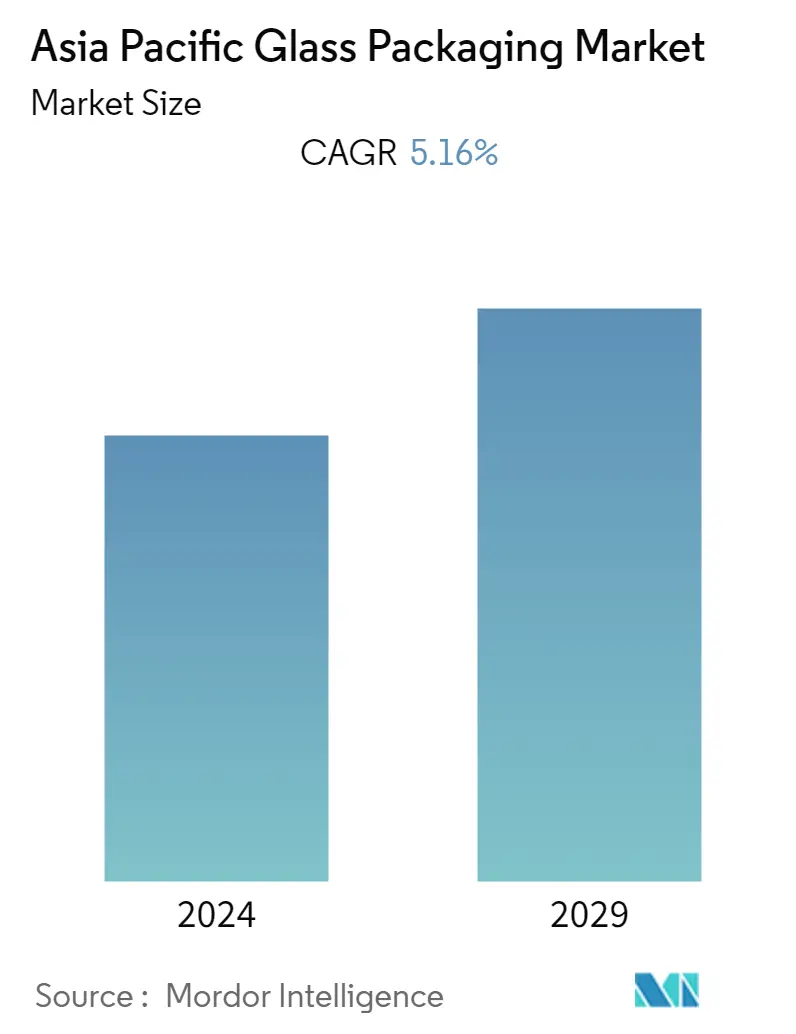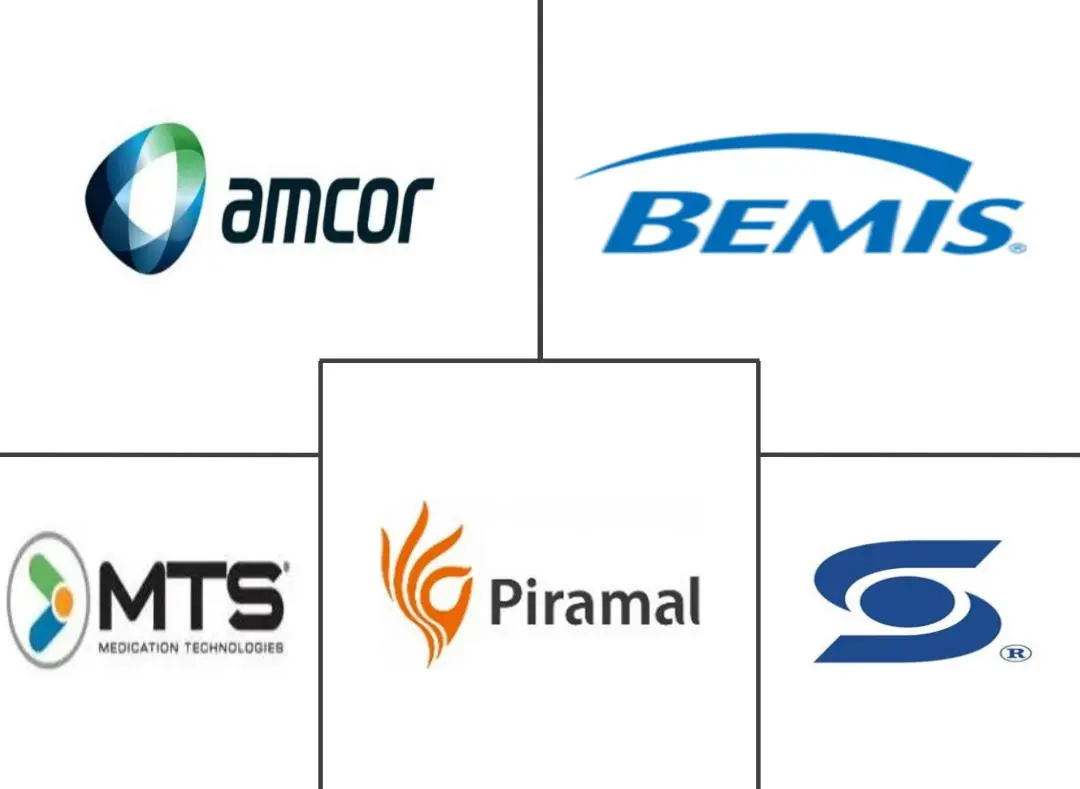Market Size of Asia Pacific Glass Packaging Industry

| Study Period | 2019 - 2029 |
| Base Year For Estimation | 2023 |
| Forecast Data Period | 2024 - 2029 |
| Historical Data Period | 2019 - 2022 |
| CAGR | 5.16 % |
| Market Concentration | Medium |
Major Players
*Disclaimer: Major Players sorted in no particular order |
Asia Pacific Glass Packaging Market Analysis
The Asia-Pacific glass packaging market will register a CAGR of 5.16% over the forecast period. The glass industry provides a range of glass packaging products for food and beverage, as well as for perfumery, cosmetics, and pharmacy. This form of packaging is considered one of the most trusted for health, taste, and environmental safety, as it maintains the freshness and security of the product inside for an extended period.
- The demand for healthier and safer packaging is boosting the growth of the glass packaging industry in different categories. Innovative techniques for shaping, giving artistic finish, and embossing make packaging more desirable to the end users. The demand for biodegradable and eco-friendly products and the growth of the beverage and food market further stimulate the growth of glass packaging.
- It is one of the most trusted forms of packaging, as it is eco-friendly, healthy, and safe. It is also considered premium because of its elite designs or finish and its ability to maintain the product's freshness and safety. It is primarily used across a range of end-user industries.
- Glass packaging is also the most desirable eco-friendly packaging due to its recyclable nature. The most significant innovation in recent times is lightweight glass, which offers the same resistance as the previous glass type with higher stability and lower CO2 emissions.
- The market for glass materials is expected to be limited by rising consumer preferences for plastic as a packaging material. Manufacturers also favor plastic because of its lightweight and flexible characteristics. As a result, the increased use of plastic as a packaging material will impact the market's growth.
- The impact of COVID-19 on the glass packaging industry is mixed. The packaging demand for healthcare, groceries, and e-commerce transportation rose sharply during the pandemic. However, the demand for luxury, industrial, and B2B transportation declined. The impact depends on the exposure to different regions and the portfolio of packaging players.
Asia Pacific Glass Packaging Industry Segmentation
Glass is one of the most preferred packaging materials for end users concerned about health and the environment. Glass has an almost zero rate of chemical interactions as it is nonporous and impermeable. Hence, glass packaging ensures that the products inside a glass bottle keep their aroma, strength, and flavor. Glasses can be recycled endlessly without loss in quality or purity, as they are mostly 100% recyclable.
The Asia-Pacific glass packaging market is segmented by end-user industry (food, beverage, personal care, healthcare, household care, and pharmaceutical), product type (bottles and jars, caps and closures, trays and containers, labels, and vials), and country (China, Japan, India, and Rest of Asia Pacific). The market sizes and forecasts are provided in terms of value (USD million) for all the above segments.
| By Product Type | |
| Bottles and Jars | |
| Caps and Closures | |
| Trays and Containers | |
| Vials | |
| Labels | |
| Other Product Types |
| By End-user Industry | |
| Food | |
| Beverage | |
| Personal Care | |
| Healthcare | |
| Household Care | |
| Pharmaceutical | |
| Other End-user Industries |
| By Country | |
| China | |
| Japan | |
| India | |
| Rest of Asia-Pacific |
Asia Pacific Glass Packaging Market Size Summary
The Asia-Pacific glass packaging market is poised for steady growth, driven by its reputation as a trusted and eco-friendly packaging solution. This market encompasses a wide range of applications, including food, beverages, perfumery, cosmetics, and pharmaceuticals, with glass packaging being favored for its ability to maintain product freshness and safety. The increasing demand for healthier and safer packaging options, coupled with innovative design techniques, is propelling the market forward. The rise in biodegradable and eco-friendly product preferences, along with the expansion of the food and beverage sectors, further fuels the growth of glass packaging. Despite competition from plastic and metal packaging, glass remains a preferred choice due to its recyclable nature and premium appeal.
The market landscape is moderately fragmented, with key players like Amcor, AptarGroup, and Piramal Glass Company investing in research and development to enhance market presence and digitize operations. The demand for glass packaging is particularly strong in emerging economies such as China, India, and Thailand, where beverage consumption is on the rise. The pharmaceutical and healthcare sectors also contribute to market expansion, with China leading due to its aging population and increased need for drug storage solutions. However, regulatory challenges in China present opportunities for local players to capitalize on the demand for glass containers. Overall, the Asia-Pacific glass packaging market is expected to experience sustained growth, supported by technological advancements and a shift towards sustainable packaging solutions.
Asia Pacific Glass Packaging Market Size - Table of Contents
-
1. MARKET INSIGHTS
-
1.1 Market Overview
-
1.2 Industry Value Chain Analysis
-
1.3 Industry Attractiveness - Porter's Five Forces Analysis
-
1.3.1 Threat of New Entrants
-
1.3.2 Bargaining Power of Suppliers
-
1.3.3 Bargaining Power of Consumers
-
1.3.4 Threat of Substitute Products
-
1.3.5 Intensity of Competitive Rivalry
-
-
1.4 Technology Snapshot
-
1.5 Assessment of the Impact of COVID-19 on the Market
-
-
2. MARKET SEGMENTATION
-
2.1 By Product Type
-
2.1.1 Bottles and Jars
-
2.1.2 Caps and Closures
-
2.1.3 Trays and Containers
-
2.1.4 Vials
-
2.1.5 Labels
-
2.1.6 Other Product Types
-
-
2.2 By End-user Industry
-
2.2.1 Food
-
2.2.2 Beverage
-
2.2.3 Personal Care
-
2.2.4 Healthcare
-
2.2.5 Household Care
-
2.2.6 Pharmaceutical
-
2.2.7 Other End-user Industries
-
-
2.3 By Country
-
2.3.1 China
-
2.3.2 Japan
-
2.3.3 India
-
2.3.4 Rest of Asia-Pacific
-
-
Asia Pacific Glass Packaging Market Size FAQs
What is the current Asia Pacific Glass Packaging Market size?
The Asia Pacific Glass Packaging Market is projected to register a CAGR of 5.16% during the forecast period (2024-2029)
Who are the key players in Asia Pacific Glass Packaging Market?
Amcor Ltd, Sonoco Products Company, Piramal Glass Company, MTS Medication Technologies (Omnicell Inc.) and Bemis Company Inc. are the major companies operating in the Asia Pacific Glass Packaging Market.

